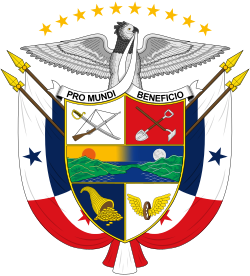 |
|---|
A referendum on expansion of the Panama Canal was held in Panama on October 22, 2006. The proposal was approved by 78% of voters.
 |
|---|
A referendum on expansion of the Panama Canal was held in Panama on October 22, 2006. The proposal was approved by 78% of voters.
According to article 325 of the Panamanian Constitution, any proposal for the construction of a third set of locks or a sea-level Canal on the existing route that the Panama Canal Authority (ACP) proposes has to be approved by the executive branch and submitted to the National Assembly for its approval or rejection. It also has to be submitted to a national referendum no earlier than three months after its approval by the National Assembly. [1]
The Panama Canal expansion proposal was presented on April 24, 2006 by President Martín Torrijos to the Panamanian people after years of study by the ACP. The largest project at the Canal since its original construction, the expansion doubled its capacity and allowed more traffic.
The project created a new lane of traffic along the Canal through the construction of a new set of locks. Details of the project included the following integrated components:
According to the ACP, the project had an estimated cost of US$5.25 billion, would be self-financed by tolls increase and would take up to 7 or 8 years of construction time.
Panama's Cabinet approved the project, and on July 14, the National Assembly unanimously approved the proposal to expand the Canal. In addition, the Assembly created and passed a law mandating a national referendum in which the people of Panama would vote to approve expansion. The referendum was held on October 22, 2006, the first Sunday at least 90 days after the legislation was signed. [3]
The referendum used a single ballot divided in half with Sí (Yes) at the left with a green background and No at the right with a red background. Above these two options the text of the question read:
Opposition to the project was vigorous as skeptics questioned the government's cost estimates and raised fears that corruption would doom the project. But the government's campaign for the expansion, the largest modernization of the canal in its history, was even more intense. Officials portrayed a "sí" vote as a vote for the children of Panama. Without an expanded canal, officials predicted, shipping traffic would find other routes and Panama's growing economy would dry up. [5]
The dates listed are normally the date the survey was concluded, not the date it was published. Most news and political affairs sources use the convention of using the last date that the poll was conducted in order to establish the inclusion/exclusion of current events. Only polls after the proposal unveiling (April 24, 2006) are included.
| Polling Firm | Date | Link | Yes | No | Undecided |
|---|---|---|---|---|---|
| Dichter & Neira | October 8, 2006 | 79% | 21% | ||
| PSM Sigma Dos | October 3, 2006 | HTML | 72% | 21% | 7% |
| CID Gallup | October 2, 2006 | HTML | 77% | 10% | 13% |
| PSM Sigma Dos | September 6, 2006 | HTML | 66% | 23% | 11% |
| Dichter & Neira | September 3, 2006 | HTML | 63.9% | 24.8% | 11.3% |
| Dichter & Neira | September 3, 2006 | HTML | 62.7% | 33.7% | 3.6% |
| Dichter & Neira | August 6, 2006 | HTML | 54.4% | 17.1% | 28.5% |
| PSM Sigma Dos | July 10, 2006 | HTML [ permanent dead link ] | 66% | 23% | 11% |
| Dichter & Neira | June 4, 2006 | HTML | 57.9% | 19.8% | 22.3% |
| Dichter & Neira | May 8, 2006 | HTML | 57.3% | 27.2% | 15.5% |
The margin of error in these surveys is typically between 2 and 2.9%. See the links for actual error values associated with particular surveys.
The voting process went smoothly, without major events that could tamper the results. The voter turnout was low, 43.32%. Voting took place on schedule from 7am to 4pm but people still in line at that time were allowed to vote. [4] Unofficial results were made known by the Electoral Tribunal by its system of unofficial results reporting, just 30 minutes after the voting ended. This system consists of series of data-collecting centers that communicate with the Panama City Press Room of the Electoral Tribunal. The centers receive the unofficial results given by each polling station by phone, cell phone and other means, while the official results begin their journey to the different counting centers. Under this system, by 6 p.m. (2 hours after the voting ended) the results of approximately 25% of polling stations were available and the likely approval of the project was known. However, the official results were the responsibility of the National Scrutiny Junta, and that took three days as official declarations came from all over the country to Panama City.
| Choice | Votes | % |
|---|---|---|
| For | 705,144 | 77.80 |
| Against | 201,247 | 22.20 |
| Invalid/blank votes | 17,638 | – |
| Total | 924,029 | 100 |
| Registered voters/turnout | 2,132,842 | 43.32 |
| Source: Direct Democracy | ||